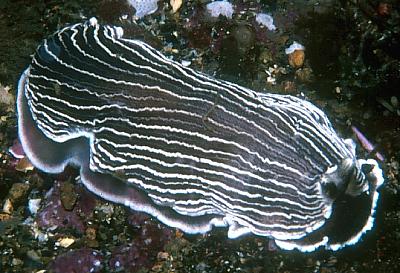
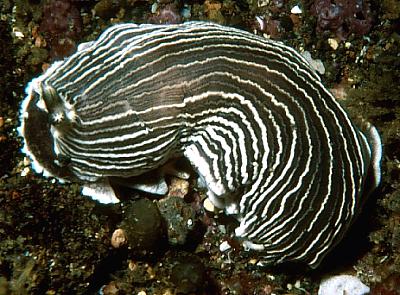
Armina californica
(Cooper, 1863)
Order: NUDIBRANCHIA
Suborder: ARMININA
Family: Arminidae
DISTRIBUTION
West coast of North America from the Gulf of Alaska south to Panama.
PHOTO
Channel Islands, California, USA, 1987. On dark sand at a depth of about 12 meters. Photos: Scott Johnson
Grows to 70mm. Like most species of Armina, it lives in sand or muddy regions and feeds on sea pens, in particular Ptilosarcus gurneyi and Renilla koellikeri. It stays buried during the day, only coming to the surface to feed at night. It causes a spectacular light show when it is feeding on the sea pen Renilla koellikeri because that species produces luminescent flashes every time it is bitten.
References:
• Bertsch, H (1968) Effect of feeding by Armina californica on the bioluminescence of Renilla koellikeri. The Veliger, 10(4): 440-441.
• Cooper, J. G. 1863. Some new genera and species of California Mollusca. Proceedings of the California Academy of Natural Sciences, 2: 202-207.
• MacFarland, F. M. 1966. Studies of opisthobranchiate mollusks of the Pacific coast of North America. Memoirs of the California Academy of Sciences, 6: 1-546, pls. 1-72.
Rudman, W.B., 2002 (October 28) Armina californica (Cooper, 1863). [In] Sea Slug Forum. Australian Museum, Sydney. Available from http://www.seaslugforum.net/find/armicali
Related messages
Re: Armina californica - feeding
June 2, 2010
From: Betty Bastai
Concerning message #20780:
I have read all the posts about Armina californica and I could not find any info on how the slung hunts.
Does it cruise under the sand until it detects a sea pen with its sense of smell, like a recent documentary about Puget Sound marine life suggests, or does it emerge from the sand, crawls on the bottom and then it finds the sea pen?
Thanks
Betty
ottersplash@gmail.com
Bastai, B., 2010 (Jun 2) Re: Armina californica - feeding. [Message in] Sea Slug Forum. Australian Museum, Sydney. Available from http://www.seaslugforum.net/find/23708Dear Betty,
Studying animals that spend a lot of time buried in the sand is difficult. Do they just bury themselves and hide/wait before surfacing again, or do they actively burrow along like moles? I am not sure that we have that sort of information on any burrowing sea slug, except for those which crawl along just beneath the surface. I assume that species of Armina use their rhinophores to smell their prey but whether or not they only do that at the surface I couldn't say. I refer on the species Fact Sheet to a study by Hans Bertsch on feeding in this species. Perhaps he could give us a better answer.
Best wishes,
Bill Rudman
Armina californica and the sea pansy Renilla
March 17, 2010
From: Kevin Lee
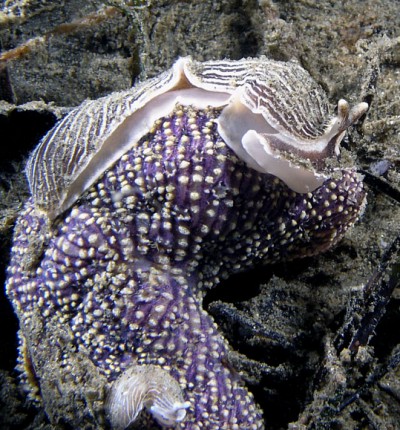
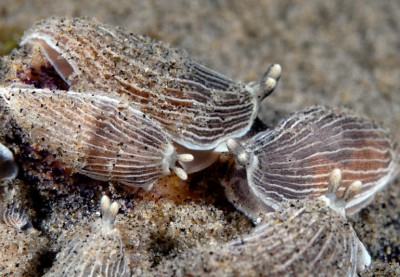
Hi Doc,
After seeing Jan Kocian's great photos of Armina & sea pens [see message #23276], and reading recent related communiques, I wanted to offer these images of Armina californica feeding on sea pansies (Renilla koellikeri), taken in La Jolla Shores, California. I have observed Armina feeding, both day and night, on this sea pansy, which dwells on/in the sandy bottom. I believe this specifically addresses your question posed in Mike Neubig's message #16674.
Locality: La Jolla Shores, 35-80 feet, California, Eastern Pacific, 16 December 2007, Sandy bottom. Length: approx. 1 inch. Photographer: Kevin Lee.
Cheers,
Kevin
diverkevin@gmail.com
Kevin Lee, 2010 (Mar 17) Armina californica and the sea pansy Renilla. [Message in] Sea Slug Forum. Australian Museum, Sydney. Available from http://www.seaslugforum.net/find/23358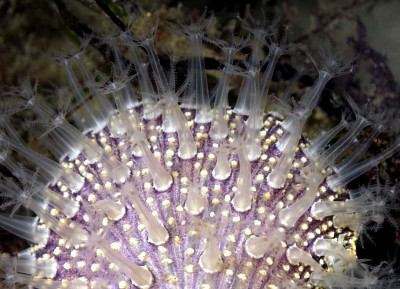
Dear Kevin,
Thanks for these photos. It has been a great week for arminid biology. I remember many years ago being fascinated by Hans Bertsch's report of Renilla 'flashing' when attacked by Armina. It must be an amazing sight.
- Bertsch, H (1968) Effect of feeding by Armina californica on the bioluminescence of Renilla koellikeri. The Veliger, 10(4): 440-441.
Best wishes,
Bill Rudman
Sea pens
March 9, 2010
From: Jan Kocian
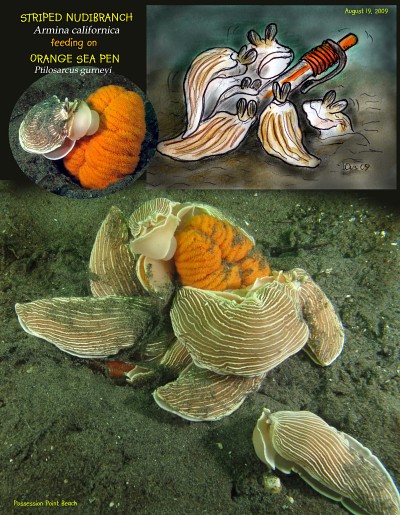
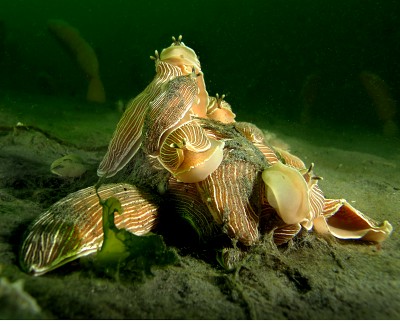
Hello Bill.
Concerning your request for a photo [message #23252], here are some Orange sea pens - Ptilosarcus gurneyi from the Eastern Pacific, for the sea pen page. The second photo illustrates what happens to them when a hungry horde of Armina californica picks one of them for lunch.
Locality: Possession Point beach,Whidbey Island, 50 feet, California, Eastern Pacific Ocean, 19 August 2009, Sandy slope. Photographer: Jan Kocian.
Jan Kocian
honkoc@hotmail.com
Kocian, J, 2010 (Mar 9) Sea pens. [Message in] Sea Slug Forum. Australian Museum, Sydney. Available from http://www.seaslugforum.net/find/23276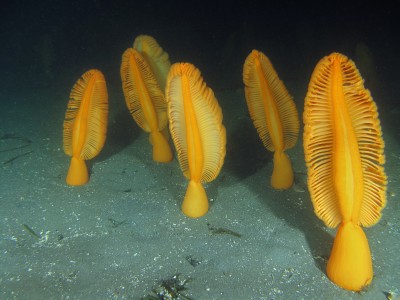
Dear Jan,
Thanks very much. I thought it would be sad to have a photo of a dead or dying sea pen to represent them, so your photo of a proud group of them standing tall is just what I wanted.
Not that your message contains a happy ending, but it well illustrates just how specialised many nudibranchs have become. Having such a specialised diet can be an advantage when the food is plentiful, but it does mean that if the sea pen population disappears for some reason the Armina population will starve.
Best wishes,
Bill Rudman
Armina californica eggs
November 6, 2007
From: Jan Kocian
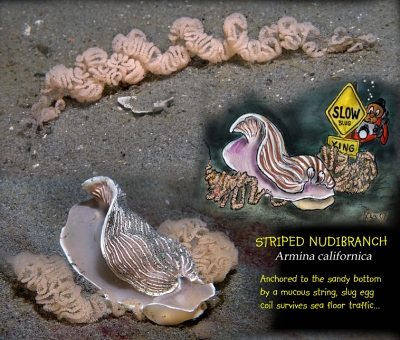
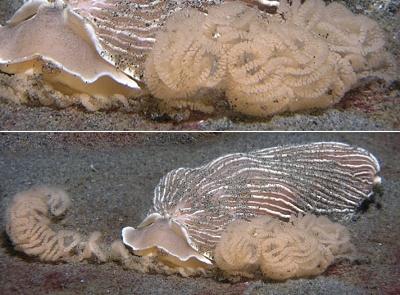
Revisited the sandy slopes of local beach, most of the Sea pens were in hiding this time, but there were plenty of Armina californica slugs to be seen, even if this again was a daytime dive. I did not see any slugs actually laying eggs, but saw one crossing one of the string of eggs, also a Sunflower star touching another batch, then leaving it alone, unharmed.
Locality: Possession Beach, Whidbey Island, 50 feet, Washington, USA, Eastern North Pacific, 1 October 2007, sandy slope. Length: 6 cm. Photographer: Jan Kocian.
Jan Kocian
honkoc@hotmail.com
Kocian, J, 2007 (Nov 6) Armina californica eggs. [Message in] Sea Slug Forum. Australian Museum, Sydney. Available from http://www.seaslugforum.net/find/20898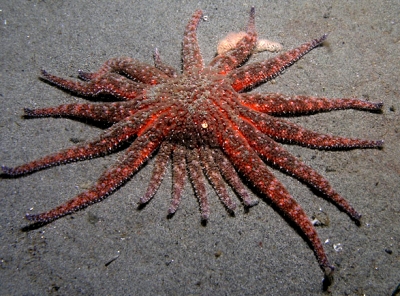
Hi Jan,
This is a great contribution. The egg mass matches perfectly that described by Ann Hurst in 1967. She had only drawings and I am sure would have loved to have included great photos like these.
This is an interesting egg mass as it is made up of a long series folds attached along one edge. Near the attachment edge, hidden under the eggs capsules in your photo, the jelly ribbon is clear. The concentration of egg capsules is along the free edge. The mass becomes a twisted ball because the attachment edge is shorter than the free edge.
Good show,
Dave Behrens
Armina californica - feeding
September 26, 2007
From: Jan Kocian
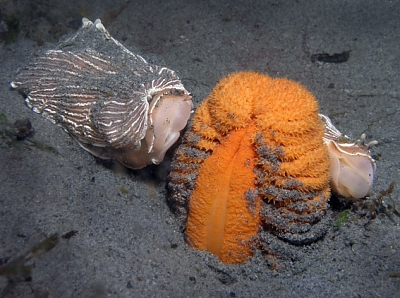
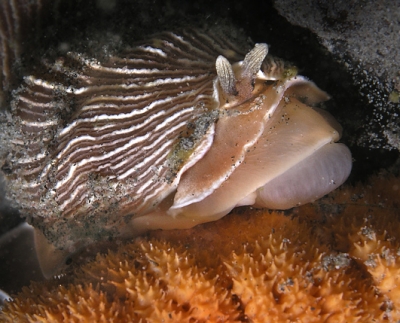
Hello Bill
I found Armina californica crowding on the sea pen Ptilosarcus gurneyi. My question is: When the sea pen retracts its polyps and curls into a fraction of its normal size, do the slugs still get their food ?
Locality: Possession Beach, Whidbey Island, 50 feet, Washington, USA, Eastern North Pacific, 19 September 2007, sandy slope. Length: 6 cm. Photographer: Jan Kocian.
Thank you.
honkoc@hotmail.com
Kocian, J, 2007 (Sep 26) Armina californica - feeding. [Message in] Sea Slug Forum. Australian Museum, Sydney. Available from http://www.seaslugforum.net/find/20780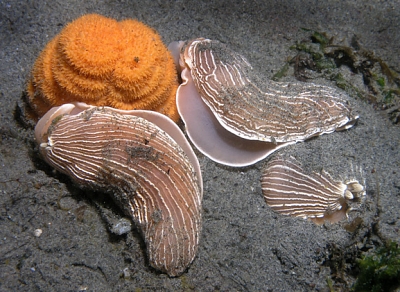
Dear Jan,
Thanks for these great photos. When a cnidarian polyp is fully extended its volume must consist of 90% water - or even more. When it contracts the water is just forced into another part of the body, but it means the contracted part has much more 'meat' per volume, so I guess as long as the sea pen body doesn't contract out of reach of the slug, the Armina doesn't lose any of its potential food.
Best wishes,
Bill Rudman
Armina californica feeding, eye spots
May 29, 2006
From: Mike Neubig
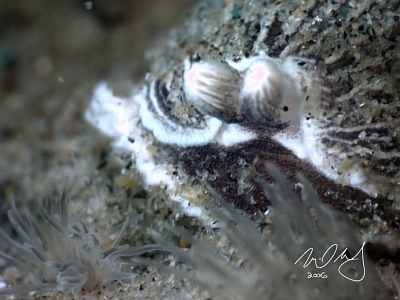
Armina californica happens to be one of my favorite nudibranchs, so it was a pleasure to find several this morning in conditions of bright sunshine and low-surge. Both photos are of the same individual, however, and in the first, I'm guessing the Armina is about to dine.
Both photos reveal a prominent black spot on the side of the head tentacle (or are they rhinophores?), which I'm guessing are eye spots. These were bilateral, and can be seen in one of Paul Sim's photos [message #14043]. It's more common for me to dive at night, and the eye spots, if that is what they are, might explain why Armina tend to dive into the sand when I position my camera rig (dual HIDs) for macro shots, and why I had much better luck in today's bright waters.
Locality: Valley-Sea-Toes, La Jolla Shores, 13m, California, USA, Eastern Pacific Ocean, 19 May 2006, sandy sloping shoulder of La Jolla Canyon. Length: 30mm. Photographer: Mike Neubig.
Mike Neubig
mike.neubig@gmail.com
Neubig, M., 2006 (May 29) Armina californica feeding, eye spots. [Message in] Sea Slug Forum. Australian Museum, Sydney. Available from http://www.seaslugforum.net/find/16674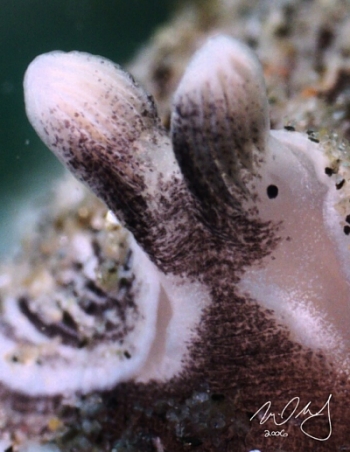
Dear Mike,
Yes the tentacles are their rhinophores. On the rhinophore Fact Sheet you will see that the arminid group are the only nudibranchs which have vertical rather than horizontal leaflets on the rhinophores.
The black spot is indeed the eye, but as they can't form images the only way you would disturb is if you cast a shadow over it [unlikely at night]. I am sure someone will be able to tell us about the daily rhythm of Armina californica. I am not sure if they are usually nocturnal, like many nudibranchs, to avoid fish predators, or whether they follow the cycle of emergence of the sea pens they feed on. I assumed that both the sea pens and Armina only emerged at night but as Jan Kocian's messages [see #14935] showed, Armina will emerge for a feed during the day if the sea pens have been ripped out of the substrate. It would be interesting to know what the food of Armina is in your area and if is sea pens, are they normally out during the day?
Best wishes,
Bill Rudman
Re: Sea Pens and Armina
October 7, 2005
From: Jan Kocian
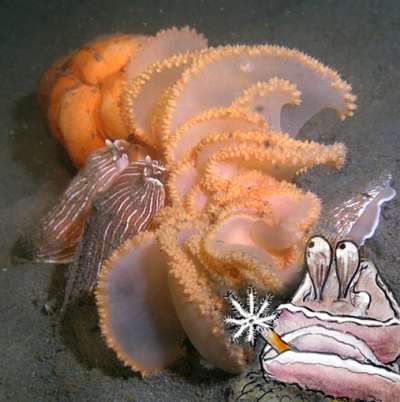
Hi Bill,
Re your question about Sea Pens [#14913], yes all four I found were "uprooted" completely, laying on the sand and their polyps gone, I was
searching for one in the process of being attacked, but during my dive found
none. I am planning to revisit the site next year.
Thanks for all your great help.
Jan
honkoc@hotmail.com
Kocian, J., 2005 (Oct 7) Re: Sea Pens and Armina. [Message in] Sea Slug Forum. Australian Museum, Sydney. Available from http://www.seaslugforum.net/find/14935Thanks Jan,
I guess the sea pens had either been washed out in a storm, or more likely attacked by something a bit bigger than Armina - a ray perhaps? Whatever it was, once they were lying defenceless on the sea bottom I guess they are fair game to anything that eats sea pens. My understanding is that Armina californica normally feeds at night, when the sea pens are fully expanded.
Best wishes,
Bill Rudman
Armina californica Last Supper?
October 5, 2005
From: Jan Kocian
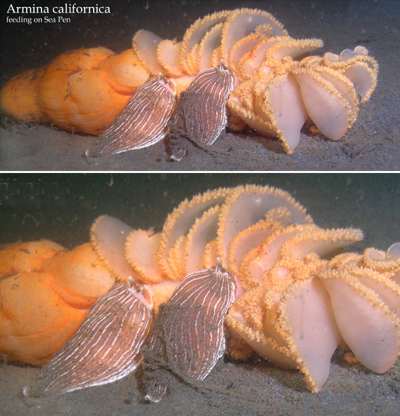
Hello Bill,
Last year, on October 2nd, I dove at Sunnyside Beach near Tacoma, [Washington, USA] and came across a forest of Sea Pens (Ptilosarcus gurneyi) and among them many Armina californica feeding on them. I had problems with my strobe firing so I did not get much of documentation. This Saturday, October 1st, I returned to the site and eagerly retraced last year dive. I did find plenty of Armina californica but very few Sea Pens. I went twenty feet deeper then last year and still, the only pens I came across were devoid of polyps. And nudibranch busy of finishing whatever was left. There were egg clusters on the sand, many of the slugs had just their rhinophores "eyes" sticking out of sand, some in pairs.
Locality: Sunnyside Beach, near Tacoma, Washington, USA. Puget Sound, NE Pacific. Depth: 85 feet. Length: 55 mm. 01 October 2005. sand. Photographer: Jan Kocian
I wonder if the Armina could eat themselves out of existence?
Jan
honkoc@hotmail.com
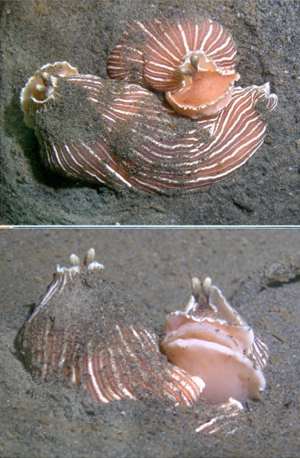
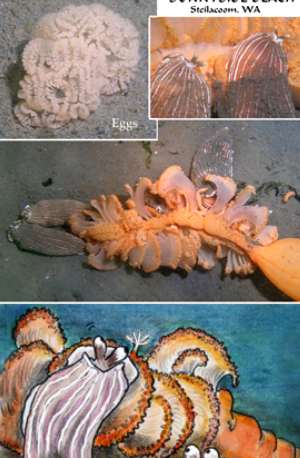
Dear Jan,
Thanks for these interesting observations. Did you find the sea pen out of the mud like this? Concerning your question about whether the Armina could eat themselves out of existence? This is always a possibility for animals with very specialised diets. When food is short, they can be in direct competition with others of the same species. This has led to many of them have very quick lifecycles. By growing to maturity quickly - and eating voraciously - they get more than their fair share of the available food supply and so are more likely to produce the next generation than are slower growing and slower feeding Armina. The other strategy they have is producing planktonic veliger larvae, which are able to move away from 'home' where the food has been eaten out, and find another supply of sea pens somewhere else.
Your finding of many egg masses shows that the present generation have done their job, and even if they die from starvation, their genes have a chance of carying on the species.
Best wishes,
Bill Rudman
Juvenile Armina californica feeding
June 14, 2005
From: Paul Sim
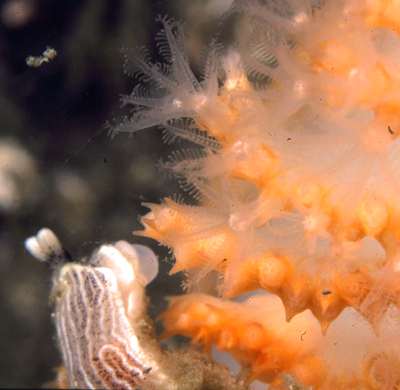
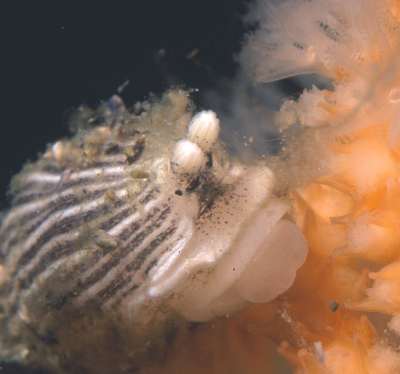
Hello Bill,
Thought you might like these ones of baby striped nudibranchs [Armina californica ] up on the sea pens, munching away. We saw many of them this evening. There was a wicked current present. Perhaps they crawled up when the sea pens were blown over? I don't know, maybe they all decided to rush the sea pens in a Blitzkrieg attack. Who knows the strategy of our slugged friends? :)
Locality: Cliff Cove, West Vancouver, BC, Canada. Pacific coast. Depth: 70 feet. Length: 1 inch. May 2, 2005. Sandy ledged wall. Photographer: Paul Sim
Paul Sim
plsim@shaw.ca
Sim, P., 2005 (Jun 14) Juvenile Armina californica feeding. [Message in] Sea Slug Forum. Australian Museum, Sydney. Available from http://www.seaslugforum.net/find/14043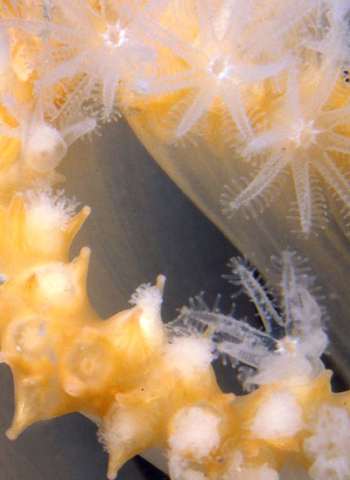
Dear Paul,
Thanks for these great photos. You are right - we still have much to learn. It is interesting how we often find a cluster of juveniles together. In some species with non-planktonic larvae it occurs because they have all just hatched from an egg mass and have not yet dispersed. In species with planktonic larvae it could mean that a 'swarm' of larvae have all settled together, or that chemical signals from the food have attracted larvae to settle at the same spot.
To change the subject completely - I have included a close-up of one of your photos to show the individual polyps of the sea pen colony. Sea Pens [Order: Pennatulacea] belong to a group of coelenterates [= cnidarians] which we call the Octocorallia. The octo - as in octopus - refers to the eight feeding tentacles each polyp has, which can be clearly seen in your photo. Sea anemones and hard corals, belong to the Hexacorallia, which have six tentacles.
Best wishes,
Bill Rudman
Armina californica from Vancouver Island
July 9, 2004
From: David Roberts
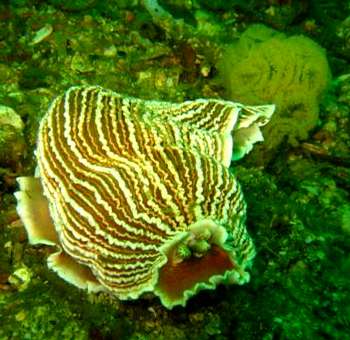
On June 6th I found an Armina californica near Shushartie Bay, Vancouver Island, British Columbia, Canada.
It was laying eggs at about 11am on a bright sunny day in 18m of water. The specimen was clean (devoid of sand on top) sitting on a bottom consisting of shell debris. (Less than a foot away was a second specimen which was partially covered in sand. I took a picture of it also but it is of poor quality.) The local topography consisted of a gently sloping shelly sand grading to shelly mud over about 50m with increasing depth. No seapens where present. Upslope about 15m away there is a rocky reef which rises to the surface and is marked by a navigation beacon (Dillon Rock). An egg mass is present behind the specimen.
David
d.roberts.108a@telus.net
Roberts, D., 2004 (Jul 9) Armina californica from Vancouver Island. [Message in] Sea Slug Forum. Australian Museum, Sydney. Available from http://www.seaslugforum.net/find/12674Thanks David,
Bill Rudman
Armina californica from Monterey, CA
February 17, 2004
From: Clinton Bauder
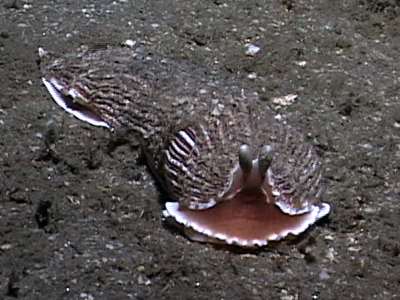
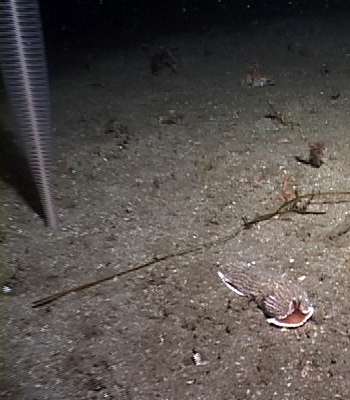
Hi Bill,
I was doing a deep dive in Monterey Bay and happened across an interesting nudibranch; Armina californica. This is a new one for me. Visibility was bad which made the dive rather like a night dive (except darker!) which may explain why this guy was out in plain sight.
I found it at the end of the dive and was a bit rushed but I think it was about 10 cm long. Depth was about 60m and the second photo shows a sea pen which may be a prey item though I did not observe that behavior.
Clinton Bauder
gecko1@apple.com
Bauder, C., 2004 (Feb 17) Armina californica from Monterey, CA. [Message in] Sea Slug Forum. Australian Museum, Sydney. Available from http://www.seaslugforum.net/find/12228Thanks Clinton,
Bill Rudman
Re: Striped Nudibranch from California
November 1, 2002
From: Scott Johnson


Hi Bill,
Here are some photos of a specimen of Armina californica found off California's Channel Islands in 1987. It was on dark sand at a depth of about 12 meters.
Scott
johnson@kmr.ll.mit.edu
Johnson, S., 2002 (Nov 1) Re: Striped Nudibranch from California. [Message in] Sea Slug Forum. Australian Museum, Sydney. Available from http://www.seaslugforum.net/find/8310Thanks Scott,
I am sure Natasha will be pleased. I have also found the reference I mentioned to her about Renilla 'flashing' while being eaten by Armina californica.
• Bertsch, H (1968) Effect of feeding by Armina californica on the bioluminescence of Renilla koellikeri. The Veliger, 10(4): 440-441.
Bill Rudman
Rudman, W.B., 2002 (Nov 1). Comment on Re: Striped Nudibranch from California by Scott Johnson. [Message in] Sea Slug Forum. Australian Museum, Sydney. Available from http://www.seaslugforum.net/find/8310Striped Nudibranch from California
October 29, 2002
From: Natasha Hopkins
Hello, my name is Natasha and I have fairly thoroughly explored the site and am having trouble finding the species, Pleurophyllidia californica, where they live, what they eat and what eats them. I'm in the state of Washington by the Puget Sound. Any info would be greatly appreciated.
Natasha Hopkins
nummaone4sho@excite.com
Hopkins, N., 2002 (Oct 29) Striped Nudibranch from California. [Message in] Sea Slug Forum. Australian Museum, Sydney. Available from http://www.seaslugforum.net/find/8297Dear Natasha,
Unfortunately this nudibranch, which is now called Armina californica, isn't on the Forum as yet. Perhaps some kind person will send us a photo so the next person who looks for it won't be disappointed. In Dave Behrens' book Pacific Coast Nudibranchs he says that it is found from the Gulf of Alaska south to Panama, and grows to a length of 70mm.
Like most species of Armina, it lives in sand or muddy regions and feeds on sea pens, in particular Ptilosarcus gurneyi and Renilla koellikeri. It spends the day burrowing only coming to the surface to feed at night. I have read an interesting article on the spectacular light show it causes when it is feeding, as the sea pen Renilla koellikeri produces luminescent flashes every time it is bitten. I will try and find a reference for you.
Best wishes,
Bill Rudman
